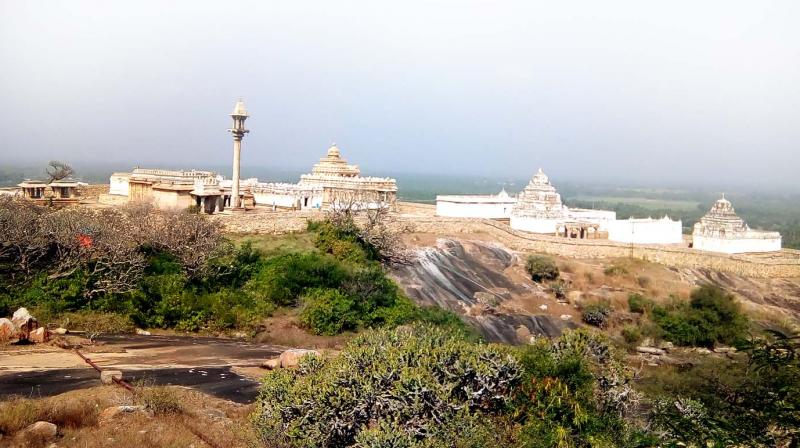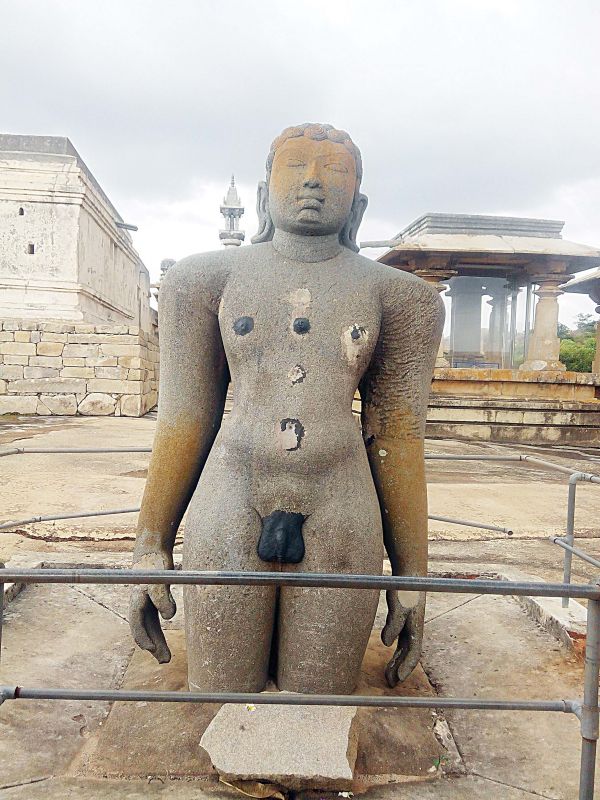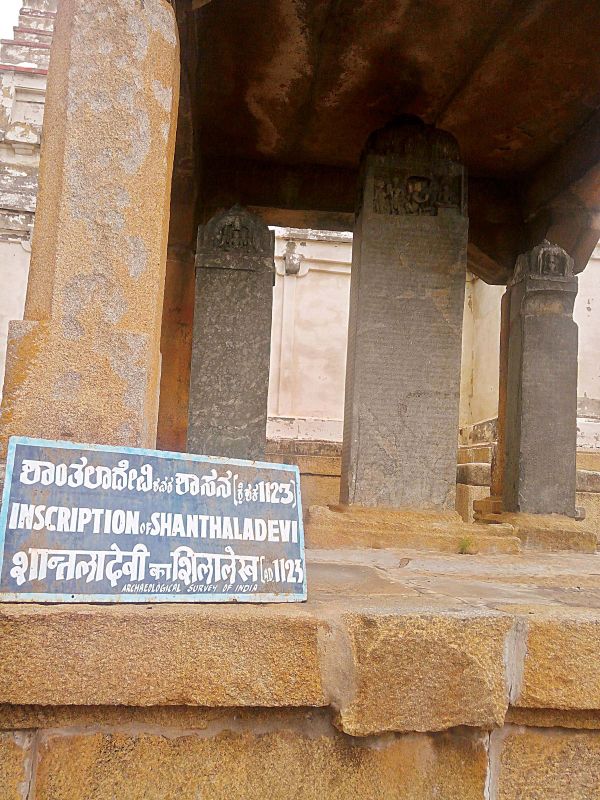Sunday Story: Chikkabetta, where time stops for the Jain legends
Chikkabetta, earlier known as Katavapra (Black Hill), is at Shravanabelagola in Hassan district.

When a religion crosses the confines of the land it was born in and conquers the minds of mortals in faraway nations, there has to be something magical and enduring about the depth of its thought and the richness of its ideals. Jainism, the ancient religion , has adherents across the globe which is not surprising considering its appeal to the human mind in search of the eternal truth. Those wonderstruck by its wisdom, did not forget to leave a legacy behind which can be seen in Chikkabetta at Shravanabelagola, now known as Chandragiri. M.B. Girish traces the precious Jain heritage of this hill, which could have been lost forever had it not been for the efforts of those who felt Jainism should thrive and continue to attract countless generations.
Shravanabelagola has many Jain bastis which could be considered architectural marvels and were built by various royal families including the Gangas, Rashtrakutas, Chalukyas of Kalyani, Hoysalas, Vijaynagar Kings and Wodeyars of Mysore. Before the Bahubali statue came up at Vindhyagiri, Chikkabetta was a prominent centre for pilgrims and continues to attract tourists as it has numerous Jain monuments which speak volumes of its revered place in history. Besides the well maintained monuments, the tranquility of the hills too makes a trip to Chikkabetta or Chandragiri memorable.
Two rocky hills- Vindhyagiri and Chandragiri- tower over Shravanabelagola town, a prominent Jain pilgrim centre in south India, and both hills have a long history. Vindhyagiri (Doddabetta in Kannada) houses the world’s largest monolithic statue of Gommateshwara or Bahubali capturing the attention of visitors while on the opposite side is Chikkabetta (meaning a small hill in Kannada) or Chandragiri, a treasure trove of Jainism loaded with 14 memorials of Jain saints called Theertankaras besides ancient inscriptions.
 Jainism had followers in Karnataka since the ancient times and its influence probably dates back to a period prior to Buddhism.
Jainism had followers in Karnataka since the ancient times and its influence probably dates back to a period prior to Buddhism.
Jainism had followers in Karnataka since the ancient times and its influence probably dates back to a period prior to Buddhism. It is also said that the progress of Buddhism was halted in Karnataka because of the influence Jainism wielded on people here.
Chikkabetta, earlier known as Katavapra (Black Hill), is at a height of 3052 feet above sea level in Shravanabelagola at Channarayapatna in Hassan district. This hill was also called Tirthagiri or Rishigiri and is famous as one of the oldest Jain pilgrimage centres of the south. Chikkabetta is now under the domain of Archaeological Survey of India (ASI).
 Bhadrabahu stayed at Chikkabetta and decided to take a vow of Sallekhana-purity of thought and fast unto death.
Bhadrabahu stayed at Chikkabetta and decided to take a vow of Sallekhana-purity of thought and fast unto death.
How did Chikkabetta become Chandragiri? History says Chandragupta Maurya, the greatest of the Mauryan kings, relinquished his throne after listening to a prophecy of famine. Chandragupta Maurya and his guru Bhadrabahu moved to the south and his 12,000 disciples reached Chikkabetta, say archaeologists referring to the Mysore Gazetter.
Bhadrabahu stayed at Chikkabetta and decided to take a vow of Sallekhana-purity of thought and fast unto death. Chandragupta Maurya decided to stay with his guru and serve him. When Bhadrabahu attained salvation in a cave in this hill, Chandragupta Maurya too followed his teacher and attained salvation at the same cave. Hence, Chikkabetta, the small hill, came to be known as Chandragiri in honour of Chandragupta Maurya.
Archaeologists say that Jains first raised their structures in wood and later on started using stones. Shravanabelagola, bestowed with rocky hills, provided a suitable location for construction of Jinanalaya or bastis, which are temples dedicated to Jain saints (Theertanakaras), stambhas or pillars and memorial slabs or Veeragallu. Chandragiri is the abode of many prominent bastis particularly the historic Bhadrabahu and Chandragupta bastis among others.
To understand the roots of Jainism in Shravanabelagola, Chikkabetta is the ideal location to begin. The monuments in this hill are inside a compound with a lawn maintained outside the compound on the hill. Benches have been installed for visitors to relax after a climb to the hill top. Once you climb the 192 steps to reach the monuments, you can catch a panoramic view of Shravanabelagola from a vantage point on the hill top with coconut plantations spread all around. After depositing footwear and carry bags at the counter, it takes a few minutes for visitors to reach the hill top. At the foothills, signboards impart details of the history of the place to visitors in Kannada, English and Hindi.
Upon reaching the hill, a path leads to a statue which is that of Bahubali’s brother Bharatha. The Bharatha image was carved by artist Arishtanemi and has been mutilated below the thighs. However, in its style, the Bharata statue resembles the Bahubali statue at Doddabetta and dates back to the Ganga period (10th century). Bhadrabahu’s feet, revered by Jains, are engraved in a cave in the hill. The Chandragupta basti is small but is the oldest built by Ganga rulers. The lattice windows of Chandragupta basti, have engraved episodes on the life of Chandragupta Maurya.
Among the bastis at Chandragiri, the Chamundaraya basti is the largest and also the most beautiful. This basti was built by Jinadevana, son of Chamundaraya, commander in-general of the Ganga dynasty, who was instrumental in chiseling the gigantic statue of Bahubali or Gommateshwara at Vindyagiri Hill or Doddabetta.
The outer walls of Chamundaraya basti, constructed around 982 AD, are decorated with pilasters and three fine friezes. There are also the Shantinatha image in standing posture measuring 11 feet in height and Suparshvanatha in sitting posture which is 3 feet tall with a canopy of a seven-hooded serpent. The Parshavanatha image at the Parshavanatha basti is the tallest of all the images in this hill measuring 15 feet in height and has a canopy of a seven-hooded serpent.
Visitors can also see Kuge Brahmastambha, a highly decorative stone pillar with an image of Lord Brahma, built in memory of Ganga King Marasimha. “This pillar once had eight elephants surrounding it in eight directions but now has only a few left,” say ASI officials. The Mahanavami Mantapa, Majjiganna basti and Eradukatte basti are among other monuments in this hill.
Ashok Kumar attached to Shravanabelagola Jain Mutt, says that history of Chikkabetta dates back several centuries before it hit prominence when Chandragupta Maurya stayed here and attained salvation. Apart from monuments, several inscriptions such as the Shantala Devi inscription add to the historic relevance at Chandrigiri. There are even a few leopards around though there are no reports of leopards attacking visitors at Chikkabetta.
As the winds of change sweep across nations and their people, felling what we considered pristine, all that we are left with are the tenets of our ancient religions and philosophies. Sites like Chikkabetta- where a thousand ascetics would have delved into the mysteries of life and death amid the stone monuments- will continue to draw the faithful in the thousands. Just to remind us about the immortality of thought and the brilliance of a religion which can never lose its lustre.

